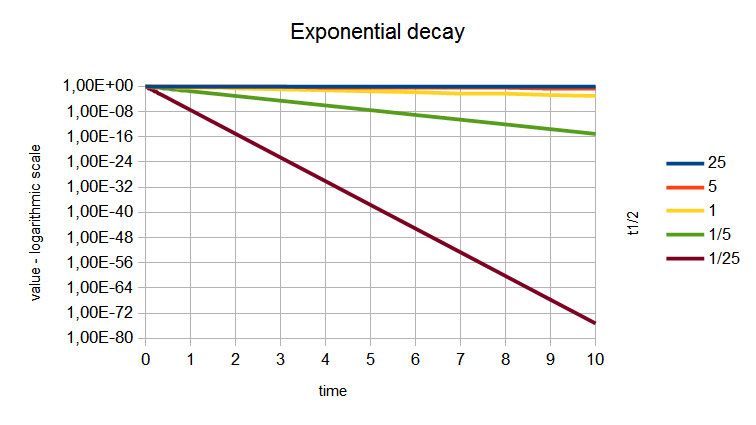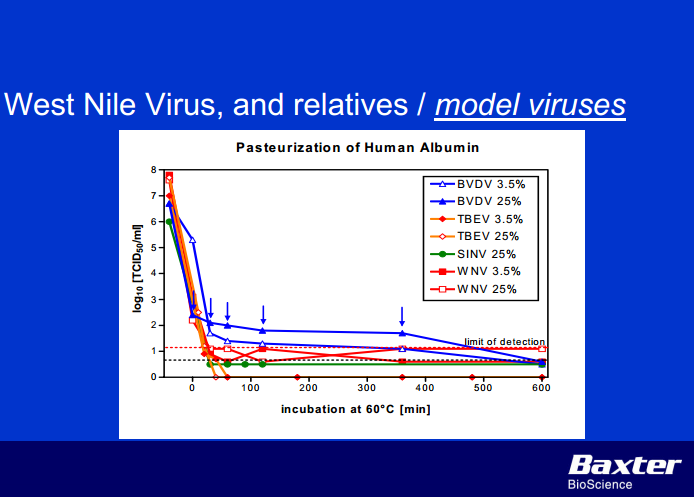It depends on TBEV strain. BtwA very basic model of virus inactivation is exponential decay. we are talking about
You can describe exponential decay with the $N(t) = N_0e^{-\lambda t}$ equation, of if you want to use half-time, then with the $N(t) = N_02^{-t/t_{1/2}}$, where $N$ is the value which reduces by time, $t$ is the time, $\lambda$ is the exponential decay constant and $t_{1/2}$ is the half-life at a certain temperature(the time required to reduce the actual value to its half). It depends
Exponential decay looks like this on diagrams:

- Figure 1 - exponential decay

- Figure 2 - exponential decay on log scale is linear
In the case of your TBEV virus, somethe $N_0$ will be the initial virus titer, the $N(t)$ will be the virus titer by a specific time, the $t$ will be the time and the $t_{1/2}$ will be the half-life, which depends on many things; TBEV strain, temperature, dry/moist heat, pH, etc...
Now real life logarithmic diagrams of themTBEV thermal inactivation are more thermoresistantlinear only by the first 30 mins or so (ethe inactivation is exponential during that period) as you can see on Figure 3.g

- Figure 3 - virus inactivation at 60°C
2004 - West Nile virus: recent experience with the model virus approach.
where $TCID_50$ is the tissue culture infective dose
By virus inactivation most of the articles like to use log 10 reduction factors. hepatitis BFor example $3 lg$ or $3 log 10$ means in this context, that lowering the initial value to $10^3 = 1000$ fold.
According to this article most of the checked TBEV strains has an inactivation index (the reduction factor difference between two temperatures) thanaround 1.7lg between 50°C and 37°C for 15 mins. So you need 15 mins at 50°C to reduce them at least $10^{1.7}=50$ fold. The reduction factor by this study was around 4lg by 37°C for 15mins (so the othersvirus count reduces certainly not just because the heat, but other environmental factors).
- 2013 - Genetic and Biological Properties of Original TBEV Strains Group Circulating in Eastern Siberia
According to another study TBEV required 6 hours of moist heat at 60°C for inactivation of 6.6 lg.
Vapor heating of a FVII concentrate in another study (which used lyophilization, followed by adding water to achieve homogenous moistening, then heating at 60°C for 10 hours, followed by heating at 80°C for one hour in an airtight container under nitrogen gas atmosphere) was evaluated for its ability to inactivate HAV, HIV-1, TBEV, PRV, and MVM. HAV was readily inactivated within one hour at 60°C (5.9 log 10 ). TBEV required six hours of this treatment for inactivation of 6.6 log 10 , and three hours were required to inactivate 6.2 log 10 of HIV-1 and 6.9 log 10 of PRV.
According to this study TBEV is considered not heat resistant, so if you are worried for example about raw milk pasteurization, then I think boiling the milk for a few minutes is enough.
Due to the lipid envelope, TBEV is readily inactivated by heat treatment, detergents and organic solvents. Even though a viremic phase is common during a TBEV infection in several animal species, foodborne infection via contaminated meat or organs is unlikely due to the fast virus inactivation at elevated temperatures.
